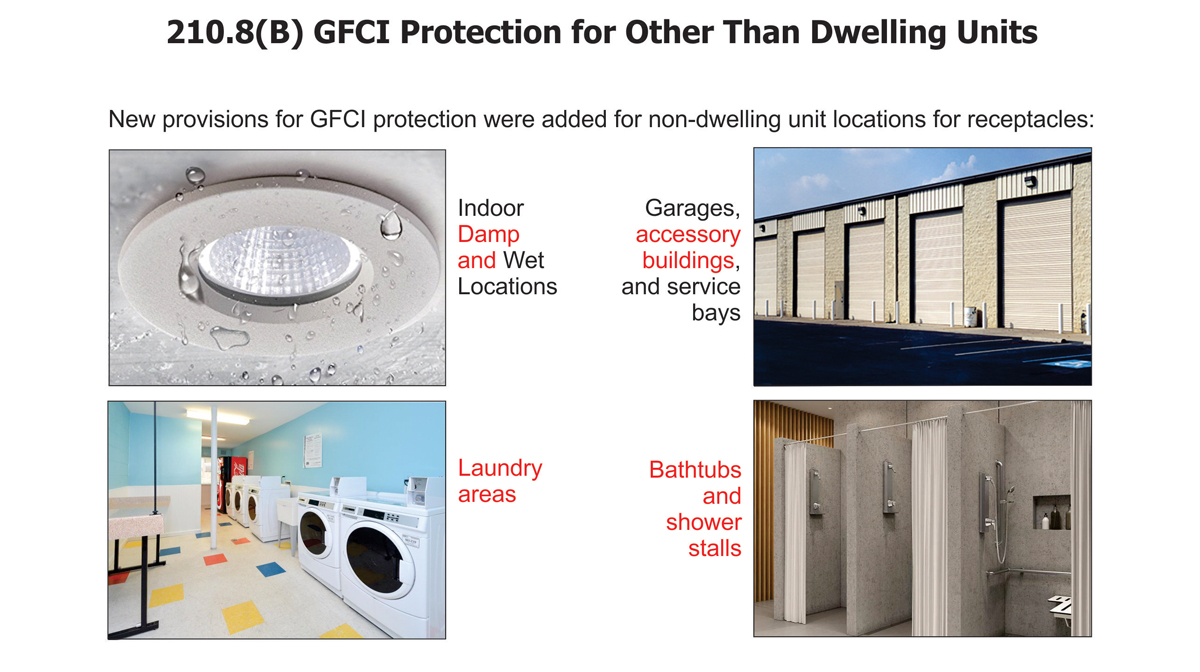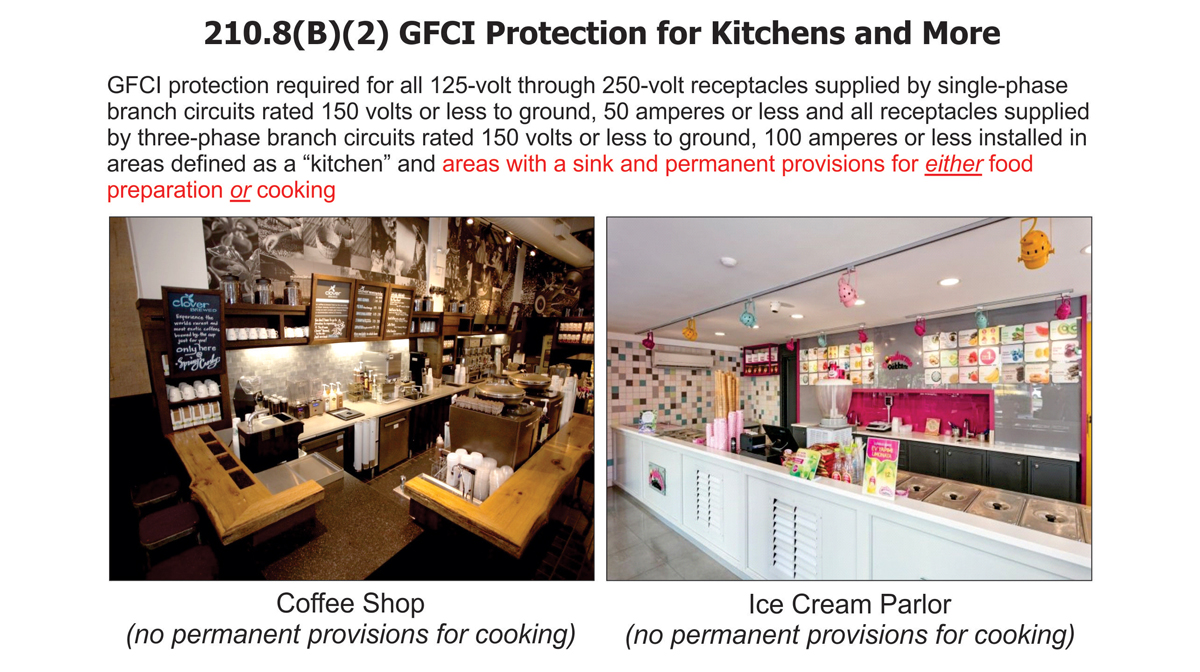210.8(B) GFCI Requirements at Non-Dwelling Unit Locations Expanded
Change Summary
- Non-dwelling unit GFCI protection has been expanded to all 125-volt through 250-volt receptacles supplied by single-phase branch circuits rated 150 volts or less to ground, 50 amperes or less and all receptacles supplied by three-phase branch circuits rated 150 volts or less to ground, 100 amperes or less installed in areas specified at 210.8(B)(1) through (B)(12).
- In addition to the areas listed in the 2017 NEC, GFCI protection was expanded to non-dwelling unit (2) kitchens or areas with a sink and permanent provisions for either food preparation or cooking, (6) indoor damp locations, (8) accessory building, (11) laundry areas, and (12) receptacles that are installed within 1.8 m (6 ft) of the outside edge of a bathtub or shower stall.
| NEC® Text |
|---|
| 210.8 Ground-Fault Circuit-Interrupter Protection for Personnel. Ground-fault circuit-interrupter protection for personnel shall be provided as required in 210.8(A) through (See NEC for remainder of Code text) (B) Other Than Dwelling Units. All (1) Bathrooms (2) Kitchens or areas with a sink and permanent provisions for either food preparation or cooking (3) Rooftops Exception: Receptacles on rooftops shall not be required to be readily accessible other than from the rooftop. (4) Outdoors Exception No. 1 to (3) and (4): Receptacles that are not readily accessible and are supplied by a branch circuit dedicated to electric snow-melting, deicing, or pipeline and vessel heating equipment shall be permitted to be installed in accordance with 426.28 or 427.22, as applicable. Exception No. 2 to (4): In industrial establishments only, where the conditions of maintenance and supervision ensure that only qualified personnel are involved, an assured equipment grounding conductor program as specified in 590.6(B)(2) shall be permitted for only those receptacle outlets used to supply equipment that would create a greater hazard if power is interrupted or having a design that is not compatible with GFCI protection. (5) Sinks — where receptacles are installed within 1.8 m (6 ft) from the top inside edge of the bowl of the sink Exception No. 1 to (5): In industrial laboratories, receptacles used to supply equipment where removal of power would introduce a greater hazard shall be permitted to be installed without GFCI protection. Exception No. 2 to (5): (6) Indoor damp and wet locations (7) Locker rooms with associated showering facilities (8) Garages, accessory buildings, service bays, and similar areas other than vehicle exhibition halls and showrooms (9) Crawl spaces — at or below grade level (10) Unfinished Exception to (1) through (5), (8), and (10): Listed locking support and mounting receptacles utilized in combination with compatible attachment fittings installed for the purpose of serving a ceiling luminaire or ceiling fan shall not be required to be ground-fault circuit-interrupter protected. If a general-purpose convenience receptacle is integral to the ceiling luminaire or ceiling fan, GFCI protection shall be provided. (11) Laundry areas (12) Bathtubs and shower stalls — where receptacles are installed within 1.8 m (6 ft) of the outside edge of the bathtub or shower stall Material taken from the National Electric Code® is reprinted with permission from NFPA 70®, 2020 edition. National Electrical Code®, Copyright 2019, National Fire Protection Association, Quincy, MA. All rights reserved. |
Expert Analysis
In the 2017 NEC, GFCI protection at non-dwelling units was limited to receptacles supplied by a branch circuit rated single phase 150V to ground or less/50A or less and 3-phase branch circuits rated 150V or less to ground/100A or less. For the 2020 NEC, GFCI protection at non dwelling units is now required for all 125-volt through 250-volt receptacles supplied by single-phase branch circuits rated 150 volts or less to ground, 50 amperes or less and all receptacles supplied by three-phase branch circuits rated 150 volts or less to ground, 100 amperes or less installed in areas locations specified at 210.8(B)(1) through (B)(12).
Also in the 2020 NEC, the GFCI provisions for 210.8(B) (2) have been expanded to include not only kitchens but “areas with a sink and permanent provisions for either food preparation or cooking.” The definition of a “kitchen” remains the same in Article 100 as “an area with a sink and permanent provisions for food preparation and cooking.” The additional added language clarifies Material taken from the National Electric Code® is reprinted with permission from NFPA 70®, 2020 edition. National Electrical Code®, Copyright 2019, National Fire Protection Association, Quincy, MA. All rights reserved. 20 that areas (not defined as a kitchen) with a sink and either permanent provisions for cooking or food preparation have the same potential for shock or electrocution hazards as a kitchen. This would include areas such as ice cream parlors, coffee shops, yogurt or smoothie stores, etc. These areas typically have stainless steel countertops and/or stainless-steel appliances but no “permanent provisions for cooking.” These facilities have at least the same potential for shock or electrocution hazards as a kitchen.

The next significant change in 210.8(B) was list Item (6) where an indoor “damp” location was added to the existing GFCI requirement for indoor wet non-dwelling unit locations. This revision occurred for clarity and consistency as the shock or electrocution hazard in a damp location is similar in nature to a wet location.
The requirement for GFCI protection for receptacles in a non-dwelling unit accessory building were added at 210.8(B)(8) that already covered garages, service bays, and similar areas other than vehicle exhibition halls and showrooms.
An exception to (B)(1) through (B)(5), (B)(8), and (B) (10) was added pertaining to “listed locking support and mounting receptacles” utilized in combination with compatible attachment fittings installed for the purpose of mounting a ceiling luminaire or ceiling fan. This exception deleted GFCI protection for these devices. GFCI protection for non-dwelling unit receptacles was intended for a traditional receptacle where a cord cap would be inserted. The same exception was also added at 210.8(A) for dwelling units.
A new List Item (11) was added to 210.8(B) that will require GFCI protection for receptacles installed in 210.8(B) GFCI Protection for Other Than Dwelling Units 21 non-dwelling unit laundry areas. GFCI requirements were added for dwelling unit laundry areas in the 2014 NEC. Laundry areas at non-dwelling units are similar to laundry areas of a dwelling unit and require the same GFCI protection.

And finally, a new List Item (12) was added to 210.8(B) calling for GFCI protection for receptacles installed within 1.8 m (6 ft) of the outside edge of a non-dwelling unit bathtub or shower stall. Shower stalls and bathtubs can exist in commercial and industrial locations outside of a locker room or bathroom for a variety of purposes.







